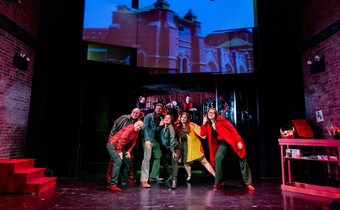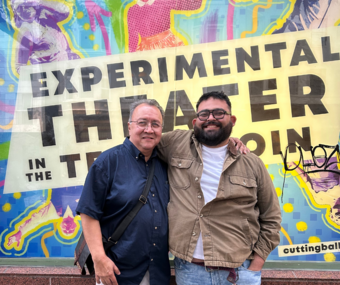Toronto, often deemed “the most multicultural city in the world,” is the largest city in Canada. There’s a thriving theatre scene here, with almost everything you could ask for, and the artists whose work we’re treated to are some of the best in the country. In this city series, you’ll hear from several of these theatremakers about the Toronto theatre landscape through their eyes. —May Antaki, series curator
Canadian Public Arts Funding and a New National Narrative
The immigration of actors between Canada and the United States generally goes one direction: south. I, however, went the other way. I was born and raised in Minneapolis, Minnesota, and, by way of Montreal and Vancouver, I now live in Toronto. (Basically I’ve lived in every Canadian city an American can name.)
The differences between my county of birth and my country of residence stick out. I now have free basic health care. There’s a holiday called Family Day and nobody quite knows where it came from. And, as a theatremaker, the Canadian government, through their financial investment in the arts, supports my livelihood. After working in Toronto as an actor and writer for almost five years, I’ve found that public funding not only affects how theatre is made, but it’s inextricably tied to the nationalism of the country that’s footing the bill.
If you look on the website of any established theatre company or even successful independent production in Toronto, you can bet they’ve received public support, and it wouldn’t be uncommon if they were funded by the Toronto Arts Council (TAC), the Ontario Arts Council (OAC), and the Canada Council for the Arts (CCA) combined. These bodies support annual operating budgets for companies large and small, festival productions, workshops, research, even individual playwriting grants (in 2018 the TAC gave out over 170,000 dollars in this last category alone). In total, the CCA gave out about 200 million dollars last year. The American equivalent, the National Endowment for the Arts, gave out about 150 million last year—but remember that the United States has about ten times the population.

Canadian money. Photo by Meddygarnet, courtesy of Creative Commons.
In practical terms, this funding means artists aren’t only getting paid when an audience is paying them. It puts more focus on development, both of careers and projects. It means that when a project is successful, it can apply for a large grant and then tour to places in Canada that generally see less theatre or participate in the world’s elite theatre festivals. On a more human level, it helps artists scrounge less when they aren’t employed that week, and, when they are, it helps theatres pay them closer to a living wage. (I can hear my Canadian friends protesting that Canadian Actors’ Equity minimum rates are still way too low, and I would agree, but when I did a play at a respected theatre in the United States recently, there were actors in the cast who would drive Uber after the show to make ends meet. I hear that story less above the 49th parallel—again, where we also benefit from more social safety nets, including free basic health care.)
For a long time this public funding concept was strange to me, and it even felt slightly greedy. I’d always believed the arts were worthwhile, but I grew up in a country where the government played little to no role in facilitating its creation. The government was for infrastructure and emergencies, and I didn’t understand why taxpayer dollars should go towards us just doing our jobs. If we couldn’t earn a decent living off ticket sales, that meant we didn’t deserve to live decently. (I can feel my Canadian friends’ eyes rolling with frightening momentum.) Turns out I was wrong and not just for all the obvious reasons. Investing in the arts benefits cities in a number of ways—the most common is that it diversifies the economy and increases the taxes collected by all the people involved in making and consuming the art. But as an American—even after I understood for the first time that economies are complicated—it still seemed bizarre that part of a government’s job was to steer its nation’s artistic ship.
While Americans often forget that we have neighbors to the north, Canada never forgets about America, and it’s this stark difference in nationalism that is the foundation of the Canadian practice to publicly funding the arts.
Growing up in the United States, we get used to not thinking much about other countries. I was raised in Minnesota, as close to Canada as one can get, and I wasn’t positive whether they had provinces or providences up there. When Americans make fun of Canada, we’re often actually making fun of our own ignorance about the country with which we share the world’s longest peaceful border. This is not the Canadian experience. Canadians are inundated with American news and culture at basically the same rate as actual Americans, so much so that Canadian news and culture can be drowned out.
This has been true for a long time, and back in 1949 Prime Minister Louis St. Laurent (remember there are French people up here) appointed the Massey Commission, also known as the Royal Commission on National Development in the Arts, Letters and Sciences (remember there’s Royal stuff up here too). The commission stated that, “Good will alone can do little for a starving plant; if the cultural life of Canada is anaemic, it must be nourished, and this will cost money. This is a task for shared effort in all fields of government, federal, provincial and local…” and it concluded that Canada faced “the very present danger of permanent dependence” from American entertainment and culture. While Americans often forget that we have neighbors to the north, Canada never forgets about America, and it’s this stark difference in nationalism that is the foundation of the Canadian practice to publicly funding the arts.

Jesse LaVercombe and Maev Beaty in Hannah Moscovitch's Bunny at Tarragon Theatre in 2018. Photo credit: Cylla Von Tiedemann
I first came to Canada to study acting at the National Theatre School of Canada, the most prestigious school in the country, and at the time almost no Americans had ever heard of it. It was the school’s fiftieth-year anniversary when I arrived and there was much jubilee, including a large panel discussion devoted to the question: “What does it mean to be a Canadian artist?” I listened as the panel struggled to nail down a solid answer to that question with the attitude that if they couldn’t find one, there would be dire consequences for the nation. It was surreal, because I had never seriously thought about what it meant to be an American—our national identity was giant and complex, but we were never taught to worry about it, and we certainly never sat down and tried to find an answer in a panel discussion. I had thought a bit about what it meant to be from Minnesota, and that thought went like this: “It’s cold. I’m pale.” I would come to learn that Canada’s national identity is worrying about its national identity.
This self-conscious, defensive Canadian attitude was necessary and productive for a time. With previous generations I believe it came from a place of great strength and, in the case of the Massey Commission, bold action. However, I think we’ve outgrown some aspects of this posture, and holding onto it has become detrimental. For decades Canada has had regulations about Canadian representation in radio and television. These Canadian Content (also known as CanCon, because we’re adorable) percentage requirements dictate how much airtime is given to, you guessed it, content created by Canadians. (There’s a whole system of how to determine what is Canadian enough that I won’t get it into, but I will tell you it’s called the MAPL system, because, again, we’re super adorable.) It guaranteed that the country was employing Canadian artists and that people were watching Canadian TV shows (because they literally had to). In this age of streaming, however, this makes less and less sense, and there’s something a tad desperate about forcing people to watch Canadian content, when, I believe, our industry is now strong enough to be competitive without the booster seat. This sense of obligation is also the exact stereotype I think we need to be pushing against.
With the privilege of our funding resources and our self-conscious tendencies, we should strive to not just raise the bar for ourselves, but to do it for the world stage, with faith that our national identity will take care of itself.
Although there aren’t CanCon regulations in theatre, there are some self-enforced ones, specifically in new work. Of course our largest theatres, like in the United States, are not generally devoted to new plays but rather to the works Shakespeare, Williams, Shaw, and a host of other older dead dudes. But it’s assumed that the theatres that develop new work will exclusively develop Canadian work, with a pretty strong taboo against putting resources into any non-Canadians. There is the Massey Commission attitude of we are fighting for a national identity, so we better not spend our precious resources on anybody else, which makes sense, and this system has created a huge and rich body of Canadian work that might not have been created otherwise… but, like CanCon, it also separates Canadian work from the rest. We hold ourselves to a slightly lower “Canadian” standard, which of course ends up just holding us back, because we’re often not very hard on ourselves. The community and the critics alike cradle bad work because it feels precious to our national ego and a taboo to criticize it honestly.
I think Canada needs a new narrative for itself that isn’t so much about buttressing a fortress or perfectly defining our national identity, but participating in a larger conversation. I’m not advocating for changes in CanCon regulations, and I’m certainly not advocating for less public funding (because it pays my rent, which in Toronto ain’t cheap), but those efforts shouldn’t come from a place of insecurity. Our public funding should be dedicated to raising the bar of our work and showing off that work to the world, not protecting us from the threat of our big brother to the south. I think the National Theatre School should accept more students from outside Canada. It's one of the best theatre schools in North America, it produces a stunning percentage of working professionals, and it's less than an hour from Vermont—but nobody south of the border knows about it because, unlike the top American or British schools, they so rarely take non-Canadians. Similarly, I think that new work developed here should mostly be Canadian, but if we share some of those resources then it will attract the attention of the international community and raise the bar for our own work. And, in my un-humble opinion, our national identity can handle it. (This isn’t uncommon in other countries. Canadian superstar Hannah Moscovitch developed her latest play at Seattle Rep, and Seattle, as of writing this, is still confidently Seattle.) Being seen by the world goes hand in hand with letting the world in. We shouldn’t feel threatened to tear down the separate standards between Canadian and non-Canadian work, we should welcome it.
There’s much evidence that we’re already moving in this more confident direction and our national narrative is evolving. Toronto’s Canadian Stage brings some of the best productions from around the globe and puts them right next to new Canadian plays and encourages international collaboration, while the city’s Soulpepper brought twelve plays to New York City a couple years ago to critical acclaim. Theatre producer Michael Rubenfeld created CanadaHub at the Edinburgh Fringe, bringing the best in Canadian work to the festival—where it regularly punches above its weight. Compared to when I arrived in Canada in 2010, I have absolutely found myself in fewer concerned conversations about what it really means to be Canadian, and more positive conversations about the work itself, the inclusion of underrepresented voices, how cool it is that Come From Away was nominated for like eight hundred Tony Awards, and what we’re all gonna do on this made up holiday called Family Day. With the privilege of our funding resources and our self-conscious tendencies, we should strive to not just raise the bar for ourselves, but to do it for the world stage, with faith that our national identity will take care of itself.











Comments
The article is just the start of the conversation—we want to know what you think about this subject, too! HowlRound is a space for knowledge-sharing, and we welcome spirited, thoughtful, and on-topic dialogue. Find our full comments policy here
I would agree with Michael that any view of the current Canadian arts landscape that does not have the indigenous voice front and centre is missing out on what has long been the missing (or silenced) perspective in the Canadian arts scene (and in the US). I don't find it odd that Howlround would look to an expat American residing in Canada to speak to his perceptions of our work, anymore than it was odd when I spoke about the American theatre movement as a (then) expat Canadian. It is a specific perspective that offers a different, albeit subjective, set of insights. That the author comes from what is, by many standards, the most Canadian (and, in fact, most art and culture supportive) State in the US skews that again.
I do agree Canadians can be 'insecure' in the way they see themselves as artists in approaching the US or greater world stage, but I think that has less to do with quality perception and more to do with our own internal conflicting identities and the way in which we view and value art.
We see it as a right - even as a basic human need - like health care. The article notes our free health care as though it is exceptional, but really the US is almost alone among substantively developed countries in not having this, and almost alone in not subsidizing art significantly as part of an internal national identity dialogue. But with that government investment comes a belief that it will always be there and that sometimes devalues it to us. We take it for granted, like roads. The safety net of government support, as so many of our European colleagues have recently discovered, must always be seen as a blessing but one that could be only one election away from disaster. We need to understand how to use civic funding to amplify and not stabilize our work and to remind people that art and investment in art is a value statement that is just as important and charitable as health care.
I would also say that, as one of the many Canadians who made a thriving life for themselves in the US arts world, it is a bit disingenuous to hold up examples of successful Canadian artists working in the US as though they are incredibly rare. Many of the largest theatre institutions and theatre training programs in the USA are run and staffed by expat Canadians. Further, many theatres in the US produce and have long produced Canadian playwrights or presented Canadian artists and productions. Hanna is a lovely example, but hardly unique. Come from away may be a Broadway success, but it was the NFP theatre industry that introduced it to the US and its commercial value is, IMHO, the least of its importance when compared to what it has to say about how we, as neighbours, should treat each other.
My two bits
While I appreciate that CanadaHub has been included in this article, I found it troubling that so much space has been given to an American to determine how Canada should or should not be focussing its attention. Most troubling to me was the absence of any perspective on Indigenous narratives, especially given that the proposal is for us to spend less time on defining identity when it has been this same inward focus that is finally resulting in a more broad understanding of the genocide that occurred in Canada. A deeper analysis would reveal that our country's "confusion" is a product of our destructive colonial history, and much of our energy towards identification is part of a process of attempting to unpack, re-learn, de-colonize and empower / re-empower those who have been systemically disenfranchised. We are years away, but the work is beginning.
You say that Canada's national identity is about "worrying about our national identity" which is, to me, a narrow reading. Yes, there is a lot of focus, because it is needed. And there is deep value in this ongoing reflection. Better Midler recently tweeted: "Maybe Trump is the President we deserve. Maybe we have become so corrupt, amoral, materialistic, greedy, ruthless, manipulative, and such liars, that he really does represent who we really are. Maybe we have been fooling ourselves the whole time." I would argue that It is a lack of reflection that lands countries in the kind of trouble that America is in right now. And it is this reflective state that I would posit has, in fact, strengthened our practices and made something like CanadaHub possible and unique within a global context.
I think that for a piece like this - with a focus on arts funding - to be truly effective, you must look at systems of subsidy around the world - not just Canada vs America. Proposing that the major strength of public subsidy is that it "diversifies the economy and increases the taxes collected" misses the point. Art subsidy exists so that a government plays an active role in helping its nation self-define, and places overt systemic value on more than simply free-market, capitalistic value properties. Subsidy is not unique to Canada, but rather, we have adopted a more European system.
You say that "With the privilege of our funding resources and our self-conscious tendencies, we should strive to not just raise the bar for ourselves, but to do it for the world stage, with faith that our national identity will take care of itself." but your only real example is "Come From Away", which is a show that's success is mostly based on how successfully it reflects Canada's national identity. Given that Come From Away has become the most economically successful Canadian shows of all time, perhaps you need to re-consider (or re-define) your idea of what "raising the bar" actually means -- because based on this example, we should be focussing even more time on embracing our self-conscious tendencies and focussing on Canadian identity.
My suggestion is that you (and we) focus more time and attention on understanding that our superpower is on our capacity to self-reflect -- and the more we place active, overt attention on this, the stronger and more inclusive we are becoming.